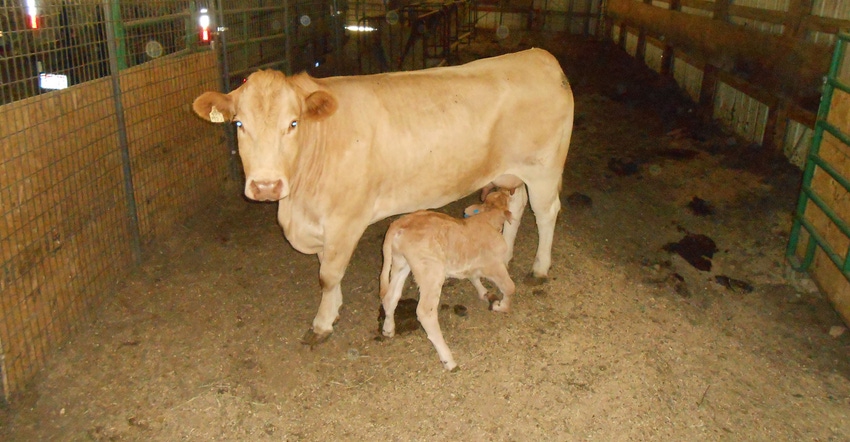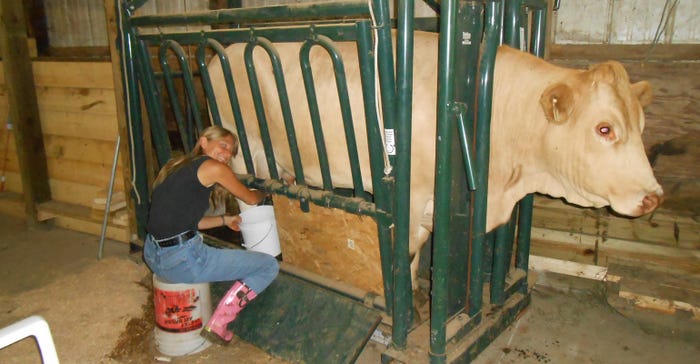March 30, 2017

By Carrie Ann Tomko
It was sunny. It was Saturday. It was springtime. But I sensed something was amiss. Calving happens most often without any human intervention. But this time, something was off.
As I strolled through the back pasture I came upon a newly born bull calf and his momma cow. Living on a beef cattle farm, I have witnessed on many occasions the sight of a newborn calf just minutes after being born. Under normal circumstances, the calf stands up, sometimes with a bit of a wobble, but is normally up and aiming toward momma cow’s udder within a short period of time.
This time, however, the calf struggled to get onto its hooves and hold himself up. Because of my sensitive intuition, I stood quietly in the distance and observed the cow-calf pair interacting at the top of a hill for as long as 45 minutes.
Suddenly, my intuitive fear was confirmed. After several attempts to stand, the calf wobbled so much so that it rolled down the hill and landed in a shallow creek. It was time to get help.
I ran to the barn to find Ken, the owner of the farm, and explained to him breathlessly: “We have a new calf, but it can’t stand up, and it rolled down the hill into the creek.” He reacted quickly by dropping the wrench in his hand and driving us in the Gator to the back pasture. En route, he stated that the plan would be to lift the calf into the bed of the Gator and take it into the barn. Momma cow would follow us.
After what seemed like a long ride, Ken and I arrived on the scene. The calf was still in the shallow creek. We lifted the calf into the Gator bed. Its legs were twisted. And we both felt doomed by the visuals of this situation.
The ride was quiet on the way back to the barn. Finally, I asked, “What are we going to do?”
As Ken was searching for a way to answer my question, we saw a pickup truck pulling into farm. It was a hay customer looking for some small squares bales. But not just any hay customer. She was a friend of ours who was an equestrian animal veterinarian. “We ask her,” was Ken’s response.
The vet friend, although versed in horses, could see the bent legs and quickly diagnosed tendon contracture. This is a condition where the joints in the knees are too tight caused by contracted flexor tendons, resulting in a knuckling over of the legs, the vet explained. And due to the crippled legs, the calf might have difficulty nursing.
With that brief diagnosis and explanation, Ken directed the vet to help herself to some hay bales. Then, he looked at me and said, “This is going to take all weekend.”
In response, I nodded, assuring him I was up for the challenge, but not sure what he meant by his comment. Still, we proceeded as planned and took the calf into the barn, while momma cow followed us to a pen with fresh bedding.
I gazed at the cow-calf pair, while Ken went to the feed room. The helpless calf lain upon a dry bedding of saw dust. The bull calf was a big boy, with his exceptionally long bent legs, helpless to stand and take his first drink of colostrum. And momma cow, she stood over her baby, licking it, bonding with it, but seemingly frustrated, too.
When Ken returned from the feed room, he had several items in hand. I looked at the collection of buckets and bottles and asked, “So now, what?”
“Now, you learn to milk a beef cow,” was his response.
With the actions that came next, the momma cow was quite cooperative. She was led into the chute and had a bucket placed under her udder. It was then I learned the technique to milking a cow by hand.

OLD WAYS: Carrie Tomko milks a beef cow whose calf had tendon contracture.

A slow and steady process, it took time to fill the bucket. As my forearms felt the pain of the repeated emptying of her teats, I gained a lot of respect for my grandfather who had only gotten milk this old-fashioned way.
With a bucket full, the milk was transferred to a bottle. The calf enjoyed its first meal.
“What a relief to see him drink,” I stated.
So, the calf was nourished, but this was just the beginning. The routine of milking the momma cow, feeding the calf, then returning the cow-calf pair to a safe pen in the barn was repeated over and over that weekend. I had aching forearms, which would be worth it, but sadly, these efforts did not seemingly improve the calf’s ability to stand.
Come Monday, the calf was looking even worse, not better. Ken informed me that, once I left for work, he was going to put the calf down. I realized that the calf was probably too weak to make it and understood the action that had to be taken.
So I prepared myself for work and prepared myself for losing the calf. I left for work, knowing the calf would soon be leaving us, too.
While driving to work in a somber state, my cellphone rang. I hardly wanted to answer it, knowing it would be the announcement that the calf’s life was over. But I answered the phone anyway and surprisingly heard Ken’s voice filled with excitement: “You are not going to believe this, but I went out in the barn with the rifle to put the calf down, and that bull calf jumped right up on its legs. He wobbled over to his momma and had a drink directly from her udder.”
“I guess he told you he wasn’t lame,” I laughed. Then, responding with joy, I added: “He is going to make it!”
That bull calf improved day by day, slowly straightening out his front legs. He began putting on the pounds and was our biggest weight-gainer of calving season that year.
In hindsight, that calf was a lot of work, almost a loss, but ultimately, a big gain. I suppose the moral of the story is this: With tendon contracture, be flexible.
Tomko writes from Rittman.
What is tendon contracture?
Tendon contracture is the result of contracted extensor tendons, resulting in forward bending of the leg. The condition, if mild, can self-correct as the calf attempts standing and exercises. With manual intervention, frequent extension of the joints to stretch the tendons aids in treatment. It is recommended that, when manually bending the legs, to inspect for abrasions due to pressure points placed on other areas of the legs. If severe contraction exists, splinting of the legs may be needed. Consult your veterinarian.
You May Also Like




